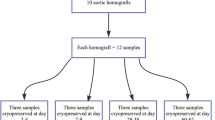Abstract
An established method for cryopreservation that might preserve the vascular and endothelial responses of human femoral arteries (HFAs) to be transplanted as allografts was studied. HFAs were harvested from multiorgan donors and stored at 4 °C in saline solution before cryostorage. Thirty HFA rings were isolated and randomly assigned to one control group of unfrozen HFAs (eight rings) and one group of cryopreserved HFAs (22 rings).
Cryopreservation was performed in RPMI solution containing dimethylsulfoxide (DMSO) and the rate of cooling was −1 °C/min until −40 °C and faster rates until −150 °C was reached. The contractile and relaxant responses of unfrozen and frozen/thawed arteries were assessed in organ bath by measurement of isometric force generated by the HFAs.
After thawing, the maximal contractile responses to the contracting agonist tested (noradrenaline) were in the range of 43% of the responses in unfrozen HFAs. The endothelium-independent responses to sodium nitroprusside were not altered whereas the endothelium-dependent relaxant responses to acetylcholine were weakly altered.
The cryopreservation method used provided a limited preservation of contractility of HFAs, a good preservation of the endothelium-independent relaxant responses, and a good preservation of endothelium-dependent relaxation. It is possible that further refinements of the cryopreservation protocol, such as a slower rate of cooling and a more controlled stepwise addition of DMSO, might allow better post-thaw functional recovery.
Similar content being viewed by others
References
Almassi G.H., Farahbakhsh B., Wooldridge T., Rusc N.J. and Olinger G.N. 1996. Endothelium and vascular smooth muscle function in internal mammary artery after cryopreservation. Journal Surgical Research 60: 355–360.
Barner H., De Weese J.A., Dale W.A. and Mahoney E.B. 1996. Aneurysmal degeneration of femoropopliteal arterial homografts. JAMA 196: 631–634.
Brock L. 1968. Long-term degenerative changes in aortic segment homografts, with particular reference to calcification. Thorax 23: 249–255.
Crawford E.S., De Bakey M.E., Morris G.C. and Garret E. 1960. Evaluation of late failures after reconstructive operations for occlusive lesions of the aorta and iliac, femoral and popliteal arteries. Surgery 47: 79–104.
Elmore J.R., Gloviczki P., Brockbank K.G.M. and Miller V.M. 1991. Cryopreservation affects endothelial and smooth muscle function of canine autogenous saphenous vein grafts. Journal of Vascular Surgery 13: 584–592.
Gournier J.P., Favre J.P., Gay J.L. and Barral X. 1995. Cryopreserved arteries allografts for limb salvage in the absence of suitable sous vein: two-year results in 20 cases. Annals of Vascular Surgery 9: S7–S14.
Key J., Bigelow W.G. and Farber E.P. 1960. Assessment of the value of arterial grafting. Surgery 47: 74–78.
Ku D.D., Willis W.L. and Caulfield J.B. 1990. Retention of endothelium-dependent vasodilatory responses in canine coronary arteries following cryopreservation. Cryobiology 27: 511–520.
Ku D.D., Winn M.J., Grigsby T. and Caulfield J.B. 1992. Human coronary vascular smooth muscle and endothelimdependent responses after storage at-75 °C. Cryobiology 29: 199–209.
Louagie Y.A., Legrand-Monsieur A., Lavenne-Pardonge E., Remacle C., Delvaux P., Maldague P. et al. 1990. Viability of long term cryopreserved human saphenous veins. Journal of Cardiovascular Surgery 31: 92–100.
Müller-Schweinitzer E., Tapparelli C. and Victorzon M. 1986. Functional studies on human veins after storage at -190° C. British Journal of Pharmacology 88: 685–687.
Müller-Schweinitzer E. 1988. Cryopreservation: a useful technique for storing tissues for pharmacological investigations. Trends in Pharmacological Sciences 9: 221–223.
Müller-Schweinitzer E. 1994. Arterial smooth muscle function after prolonged exposure to a medium containing dimethyl sulfoxide and storage at -196° C. Cryobiology 31: 330–335.
Müller-Schweinitzer E., Mihatsch M.J., Schilling M. and Haefeli W. 1997. Functional recovery of human mesenteric and coronary arteries after cryopreservation at -196° C medium. Journal of Vascular Surgery 25: 743–750.
Müller-Schweinitzer E., Stulz P., Striffeler H. and Haefeli W. 1998. Functional activity and transmembrane signaling mechanisms after cryopreservation of human internal mammary arteries. Journal of Vascular Surgery 27: 528–537.
Nataf P., Hadjiisky P., Lechat P., Mougenot N., Peuchmaurd M., Gouezo R. et al. 1995. Effect of cold anoxia on cryopreservation on metabolic and contractile functions of human internal mammary artery. Cryobiology 32: 327–333.
Passani S.L., Angelini G.D., Breckenridge I.M. and Newby A.C. 1988. Endothelial function can be preserved during cryostorage of human saphenous vein. European Journal of Cardio-Thoracic Surgery 2: 233–236.
Sheranian L.O., Edwardsm J.E. and Kirklin J.W. 1959. Late results in 110 patients with abdominal aortic aneurysm treated by resectional placement of aortic homograft. Surg. Gynec. Obst. 109: 309–314.
Song Y.C., Hunt C.J. and Pegg D.E. 1994. Cryopreservation of the common carotid artery of the rabbit. Cryobiology 31: 317–329.
Song Y.C., Pegg D.E. and Hunt C.J. 1995. Cryopreservation of the common carotid artery of the rabbit: optimization of dimethyl sulfoxide concentration and cooling rate. Cryobiology 32: 405–421.
Stanke F., Riebel D., Carmine S., Cracowski J.L., Caron F., Magne J.L. et al. 1998. Functional assessment of human femoral arteries after cryopreservation. Journal of Vascular Surgery 28: 273–283.
Wagstaff S.A. and Grigg M.J. 1996. Arterial homografts - apossible solution to an infective dilemma. Cardiovascular Surgery 4: 796–800.
Wusteman M., Busza A., Boylan S., Hayes A. and Pegg D. 1995. Ethylene glycol permeation and toxicity in the rabbit common carotid artery. Cryobiology 32: 428–435.
Author information
Authors and Affiliations
Corresponding author
Rights and permissions
About this article
Cite this article
Rendal Vázquez, M.E., Rodríguez Cabarcos, M., Martínez Santos, M. et al. Functional assessment of cryopreserved human femoral arteries for pharmaceutical research. Cell Tissue Banking 5, 105–110 (2004). https://doi.org/10.1023/B:CATB.0000034085.37937.33
Issue Date:
DOI: https://doi.org/10.1023/B:CATB.0000034085.37937.33




